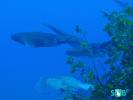 Advice on Scuba Diving in Izu Peninsula and Izu Islands, Japan
Advice on Scuba Diving in Izu Peninsula and Izu Islands, Japan
Part 1: Overview of Scuba Diving in Izu Peninsula and Izu Islands, (Japan)
The Izu Peninsula is a mountainous peninsula about an hour train ride from central Tokyo, but to get down into the peninsula travel time is about three hours plus. Izu Peninsula offers the most popular and accessible scuba diving destinations on the Japanese mainland. Many dive shops are out of the Tokyo area and dive excursions often begin in Tokyo train stations.
The Izu Peninsula is most famous for its many natural hot springs and resorts and for Japan's first dive sites. Interestingly, the peninsula itself is part of the Philippine plate and is thrusting into the main island of Honshu creating the hot springs, Tokyo's earthquakes and amazing underwater coastal features ideal for scuba diving. This is an amazing, unique dive destination.
The eastern shore of the Izu Peninsula has the most popular and crowded dive sites due to the accessibility to Tokyo and its many trains. Some of the dive sites off eastern shore are so popular that divers actually stand in line to enter into the water! The more remote and harder to get to western coast is much more laid back and unspoiled. The most beautiful west coast dive destination is reportedly the little bay town of Osezaki.
The Izu Islands are a chain of islands extending southward off Izu Peninsula. The Izu Islands, closer to the mainland, are accessible by ferries and short flights from Tokyo and offer good dive sites and reefs. The island of Hachijo is a great island to explore; it has established dive sites and dive shops.
The remote Ogasawara Islands, also known as the Bonin Islands, are the very farthest islands in the long chain of islands off of Tokyo (and technically part of Tokyo). The islands extend far into the Pacific and into warmer southern waters ideal for scuba diving. The remote, hard to get to, Ogasawara Islands are featured in a separate article about Japan's dive destinations.
Part 2: Dive Sites, Marine Life & Environment in Izu Peninsula and Izu Islands, (Japan)
For scuba divers looking to dive close to the Japanese mainland, the established dive sites off the Izu Peninsula will not disappoint. The peninsula's popular east coast dive sites are very easy to access via train, hop flight or vehicle from Tokyo and Yokohama. There are also trains from Kyoto and Nagoya that make their way down in the peninsula.
Izu Oceanic Park on the eastern coast of Izu Peninsula is not far from Tokyo and a great place to start a Japanese scuba diving adventure. Izu Kaiyo Koen, or Izu Ocean Park (IOP) was the first Japanese dive site officially designated for scuba diving back in 1965. Only a 45-minute bullet train ride from Tokyo, this eastern coast destination offers dives offshore from the hot spring resort town of Atami. This is also a great harbor to catch the ferry to the Izu Islands. The dive sites in the oceanic park reportedly offer great dive conditions year round. The park is great for families and offers salt-water swimming pools, showers and rinse tanks. The rock formations that jut into the water from the beach offer some great dive sites. The dive site known as IOP Beach-Left is the historic dive site that was the first in Japan. It offers a beginners level dive and a lot of marine life. IOP Beach-Right is a more advanced dive site where the bottom tapers down to about 30 meters.
Off the western coast of the Izu Peninsula are other famous dive sites off the small harbor town of Osezaki. The great Mt. Fuji with its snowy peak is visible from Osezaki. To get to the dive sites here you need to tote your gear, sometimes a mile across the black sand, to access the shore dive entry points within Osezaki Bay and just outside the bay as well. Once you get past the surf, the visibility here is known to be consistently good. At 110 feet you enter a zone of healthy reef and marine life decorated with red sea fans and abundant coral. You will most likely spot resident Japanese golden hawkfish, Devil scorpionfish and more Dragon morays. The Sand anemones along the sandy bottom are large and beautiful, often with purple tips.
As you drive down the Izu Peninsula there are popular dive sites such as Futo, a site off the town of Yawatano, famous for Japanese eagle rays. Here you have to carry your gear through a beach in order to access the shore diving. This location can be very popular and crowded especially on Japanese holidays and warm weekends. The good news is that summer water temperatures stay as high as 27 degrees C (or the lower 80 degree F) range. The reef offers lots of marine life such as the tiger cowrie, a tiny fish that mimics the coral polyps. At this location you can see bright yellow and black armored Pinecone fish, gold and white Dragon moray hiding out in crevasses or Clark's anemone fish hanging out in their anemone homes. The coral here is reportedly large and healthy and you can spot rays, Frogfish, Marbled rockfish and Zebra crab among many more inhabitants.
The small island just off the peninsula is called Mikimoto, accessible via a bridge from the mainland located in the Bay of Toba. The waters off Mikimoto offers deep, clear scuba diving, recommended for advanced divers due to the notoriously strong currents. Mikimoto is known as the Pearl Island and offers pearl diving shows by traditional, Japanese, female pearl divers. As mentioned, this area is for advanced divers and is worth a trip down the Izu Peninsula. The dive site is famous for the schooling Hammerhead sharks that frequent the area in the summer months. There is also a pearl diving museum where you learn that the island itself is named after Mikimoto Kokichi, the first person to successfully cultivate pearls back in 1893. The Toba Aquarium is very close to the Pearl Island.
A boat or plane ride away is Hachijo Island, a popular dive destination in the Izu Islands off the Izu Peninsula. 290 kilometers from Tokyo, the island lies along the Japan Current (Kuroshio) and while the waters are still a bit on the chilly side, the current supplies life giving waters that support amazing reefs, marine life, and therefore great scuba diving. There are shore dive sites and boat dive sites around the island. Yaene, Nazumado, Sokodo and Ochiyogahama are all dives accessible from the shores around the island. The great part about Hachijo is that the reef lies just offshore a lot of the island. Water temperatures range from up to 25 degrees C (77 degrees F) in summer months, and down to 18 degrees C (64 degrees F) in winter months. Average visibility is about 50-60 feet. Some notable offshore boat accessible dive sites are Kyokuchouhama off the northeast coast, and Uroune off the southeast coast.
While most divers dive the Izu Peninsula in the summer months, consider diving in the winter with a dry suit. Visibility increases and crowds greatly decrease.
Part 3: Dive Shops, Airports & Logistics of Diving in Izu Peninsula and Izu Islands, (Japan)
Traveling to the dive destinations off the Izu Peninsula and the Izu Islands usually involves flying into Tokyo. Tokyo's Narita International Airport, otherwise known as New Tokyo International Airport, handles most of the international flights. Tokyo International Airport, also called Haneda Airport, traffics most of the domestic flights. From Tokyo, there are many hop flights to the seemingly countless towns and islands, making up the long chain of possible destinations.
The Izu Peninsula was where scuba diving started in Japan and the area offers a good selection of dive shops and instruction. The challenge for English speaking tourists is to find a shop whose in-house staff and dive instructors speak English. A prominent dive shop ran by English natives is Tokyo based Mar Scuba. The shop specializes in diving the Izu Peninsula and meets at the McDonalds across from the Atami Station daily. Tokyo European Divers is another club/dive shop that caters to English and Swedish speaking scuba divers. Located in Tokyo, the dive shop offers weekend and day trips to great dives along the peninsula. A smaller dive school that also offers trips to the peninsula is Toyko's Triumph Diving Service. This little shop has its own dive boat and caters to families.
In Ito, along the eastern coast of the peninsula not far from Tokyo, there are several dive shops. Bonzo Divers is a shop that regularly dives the eastern dive sites and has an interest and love for the marine life. On the west coast is probably one of the most beautiful dive locations in the bay of Osezaki. The dive shops known as Mic21 are a retail sporting goods shops that cater to scuba divers and are found throughout Tokyo and Japan. The Tokyo shops offers dive courses and excursions, specializing in the Izu Peninsula and are resources for divers wishing to access the remote western coast of the peninsula.
For divers looking to dive the Izu Islands, a good place to fly into is Hachijojima Airport, on the Izu Island of Hachijo. The flight from Tokyo takes only 45 minutes. Hachijo offers great diving and is a getaway from the big city of Tokyo and the busy Izu Peninsula. Another way to get to Hachijo is the ocean liner ran by Toakai Cruise Line that departs nightly from Tokyo Bay and arrives into Hachijo the next morning. Once on the island the resort known as Seapiross on the northeast part of the island is a great resource for scuba divers who want to explore the islands' shore and boat diving locations. The hotel has a dive shop that offers scuba equipment for those who want to shore dive. The shop also has its own dive boat that offers offshore excursions. The resort is a short drive from Hachijojima Airport.
In general, ferries are most easily accessible to the Izu Islands from the peninsula's harbor towns of Takehiba Pier, Atami and Ito.
---- Book Your Diving ----
Fill in the Form Below.
Our hand picked regional partners will deliver no obligation quotes.
Tweets by @DiveAdvisorApp



